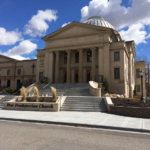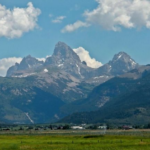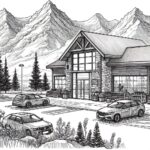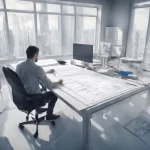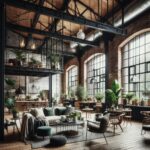Located in the picturesque state of Idaho, Idaho Falls stands as a hidden gem, boasting architectural marvels that have withstood the test of time. From historic buildings to contemporary designs, this city is a treasure trove for architecture enthusiasts and history buffs alike. Embark on a captivating journey as we delve into the rich architectural heritage of Idaho Falls, uncovering the secrets behind its captivating structures and the stories they tell.
Embracing a blend of influences, Idaho Falls showcases an array of architectural styles, ranging from Victorian and Colonial Revival to Modernist and Art Deco. Walk through the streets, and you’ll witness the grandeur of structures that evoke a sense of nostalgia and reflect the city’s growth and transformation over the years.
Step back in time as you explore iconic landmarks like the Idaho Falls Idaho Temple, a magnificent place of worship renowned for its exquisite design. Delve into the history of the Colonial Theatre, lovingly restored to its former glory, which exudes an old-world charm. Discover the innovative designs of the Idaho National Laboratory, pushing the boundaries of sustainable architecture.
Join us on this journey through time and design as we uncover the architectural marvels that make Idaho Falls a fascinating destination for enthusiasts and admirers of architectural heritage.
Historical Landmarks in Idaho Falls
Idaho Falls is rich in historical landmarks that reflect its past and showcase the evolution of architectural styles over time. One of the most significant landmarks is the Idaho Falls Idaho Temple, which stands majestically overlooking the city. Completed in 1945, this temple is not only a spiritual haven for many but also an architectural wonder. Its design features classic elements of neoclassical architecture, including a prominent spire and grand entrance. The temple’s serene gardens and reflective pools add to its beauty, making it a beloved site for both worshippers and visitors alike.
Another important historical site is the Colonial Theatre, which opened its doors in 1919. This charming building was originally designed with a variety of architectural influences, including Beaux-Arts elements that create an inviting facade. After years of neglect, the theatre underwent a comprehensive restoration in the early 2000s, returning it to its former glory. Today, it serves as a cultural hub for the community, hosting various performances and events while preserving its historical significance.
The Idaho Falls Post Office, built in 1935, is also a noteworthy landmark. Designed in the Art Deco style, this structure features intricate stone carvings and a stunning interior that showcases the craftsmanship of the era. As a vital part of the city’s history, the post office has witnessed countless stories unfold, from the arrival of letters to the community to the evolution of communication methods. These landmarks, along with many others, contribute to the rich tapestry of Idaho Falls’ architectural heritage and provide a glimpse into the city’s vibrant past.
The Influence of Different Architectural Styles in Idaho Falls
The architectural landscape of Idaho Falls is a testament to the diverse influences that have shaped its design over the decades. The city’s buildings reflect a mixture of styles, from Victorian and Colonial Revival to Modernist influences, each contributing to the unique identity of the area. The Victorian era, for instance, left a notable mark on Idaho Falls with its intricate detailing and ornate designs. Many homes from this period still stand, showcasing features like decorative trim and asymmetrical facades that evoke a sense of nostalgia.
Colonial Revival architecture is also prominent in Idaho Falls, characterized by its symmetrical design and classic elements. Many public buildings and residences from the early 20th century exhibit these traits, often adorned with columns and pediments that pay homage to colonial American architecture. This style not only emphasizes grandeur but also reflects the values of stability and tradition, which resonate with the community’s history.
As the 20th century progressed, Modernist architecture began to influence Idaho Falls, bringing a shift towards simplicity and functionality in design. This style emphasizes clean lines, open spaces, and the use of new materials, representing a departure from the ornate styles of the past. Buildings like the Idaho National Laboratory exemplify this trend, showcasing innovative designs that prioritize sustainability and efficiency. The blend of these architectural styles creates a rich visual narrative that tells the story of Idaho Falls and its evolving identity.
Notable Architects and Their Contributions to Idaho Falls’ Architecture
Idaho Falls has been shaped by the vision and creativity of several notable architects whose contributions have left an indelible mark on the city’s architectural landscape. One prominent figure is Frank H. Paradice, an influential architect in the early 20th century who designed several key buildings in Idaho Falls. His work on the Lincoln School and the former Idaho Falls High School showcases his ability to blend form with function, creating educational spaces that were both aesthetically pleasing and practical for the community’s needs.
Another significant architect is John McCarty, known for his contributions to the city during the mid-20th century. He designed several commercial buildings that reflect the modern architectural trends of the time. His work often emphasized the use of natural light and open spaces, which can be seen in structures like the Idaho Falls Library. McCarty’s designs not only catered to the functional aspects of the buildings but also considered their integration with the surrounding environment, enhancing the overall aesthetic of Idaho Falls.
Additionally, the partnership of architects R. C. Hutton and H. D. Hutton played a crucial role in shaping the downtown area. Their collaborative efforts resulted in several iconic buildings, including the Idaho Falls Civic Auditorium. This venue stands as a testament to their commitment to creating spaces that foster community engagement and cultural expression. The architectural legacy of these individuals and their innovative designs continues to inspire appreciation for the rich history and development of Idaho Falls.
Iconic Buildings in Idaho Falls
Idaho Falls is home to various iconic buildings that encapsulate the city’s architectural diversity and cultural significance. One of the most recognizable structures is the Idaho Falls Idaho Temple, which not only serves as a place of worship but also as a visual landmark for the community. The temple’s elegant design, featuring a striking spire that reaches toward the sky, is complemented by beautifully landscaped grounds that invite visitors to explore its serene environment. This building has become a symbol of faith and community unity, drawing people from all walks of life.
The Colonial Theatre also stands out as an iconic venue that has played a vital role in the cultural life of Idaho Falls. With its historic charm and beautifully restored interior, the theatre hosts a variety of performances, film screenings, and community events. The building’s unique architectural details, such as its marquee and vintage decor, transport visitors back in time, creating an atmosphere that embraces nostalgia while celebrating contemporary artistry. This venue not only serves as a hub for entertainment but also as a reminder of the city’s rich cultural heritage.
Another notable building is the Idaho Falls City Hall, which embodies the principles of civic pride and public service. Constructed in the early 20th century, this structure showcases elements of the Classical Revival style, characterized by its symmetrical design and grand entrance. The building serves as a focal point for local government and community engagement, symbolizing the commitment of Idaho Falls to its residents. Together, these iconic buildings contribute to the unique character of Idaho Falls, inviting both locals and tourists to appreciate the city’s architectural treasures.
Modern Architectural Developments in Idaho Falls
As Idaho Falls continues to grow and evolve, modern architectural developments have emerged, reflecting contemporary design trends and sustainability practices. One of the most significant projects is the Idaho National Laboratory, which has redefined the landscape of scientific research in the region. The laboratory’s innovative buildings incorporate cutting-edge technology and environmentally conscious design, making it a leader in sustainable architecture. Features such as energy-efficient systems and green roofs not only enhance the functionality of the structures but also align with the laboratory’s mission to promote research and development in clean energy.
Another notable development is the expansion of the Idaho Falls Downtown area, where new commercial spaces and mixed-use buildings have been introduced. These modern designs emphasize open layouts, natural light, and community-oriented spaces that foster interaction among residents and visitors. The integration of local materials and artistic elements in these buildings adds a unique touch, ensuring that they complement the historical context of the city while embracing a forward-thinking approach.
Additionally, housing developments in Idaho Falls have also embraced modern design principles, incorporating sustainable practices and innovative layouts. Many new residential projects focus on creating energy-efficient homes that prioritize comfort and functionality. These developments often feature open floor plans and outdoor living spaces, catering to the preferences of contemporary homeowners. The blend of modern architecture with the city’s historical elements creates a dynamic environment that continues to attract new residents and businesses to Idaho Falls.
Preservation and Restoration Efforts in Idaho Falls
Preservation and restoration efforts in Idaho Falls play a crucial role in maintaining the city’s rich architectural heritage. Community organizations and local government initiatives have come together to protect historical landmarks and ensure that the stories behind these buildings are not forgotten. One of the key projects has been the restoration of the Colonial Theatre, which faced the threat of demolition before passionate advocates rallied to save it. The successful restoration preserved its unique architectural features while revitalizing it as a cultural venue for the community.
Another significant preservation effort is the ongoing maintenance of the Idaho Falls Post Office, which stands as a testament to the city’s architectural past. Local preservationists work diligently to protect the building’s original character, ensuring that its Art Deco elements remain intact. This commitment to preservation not only honors the craftsmanship of earlier generations but also provides a sense of continuity for residents who appreciate the historical significance of the structure.
In addition to individual buildings, broader preservation initiatives aim to protect entire neighborhoods and districts within Idaho Falls. Efforts to create historical districts help maintain the architectural integrity of these areas, allowing residents and visitors to experience the charm of the past while supporting modern development. By fostering a sense of community and encouraging historical awareness, these preservation efforts contribute to the ongoing narrative of Idaho Falls, ensuring that its architectural legacy endures for future generations.
Exploring Idaho Falls’ Architectural Gems
Exploring the architectural gems of Idaho Falls is an enriching experience that reveals the city’s history and cultural identity. A leisurely stroll through the downtown area offers a glimpse of various architectural styles, from historic buildings to contemporary designs. The self-guided architecture walking tour is a popular way to engage with Idaho Falls’ rich heritage, providing insights into the significance of each structure. Visitors can marvel at the intricate details of the Victorian-style homes, the grandeur of the Idaho Falls Idaho Temple, and the charming facade of the Colonial Theatre.
In addition to the walking tour, guided tours led by local historians and architects offer deeper insights into the stories behind the buildings. These tours often include visits to lesser-known sites that showcase the city’s hidden architectural treasures. Participants have the opportunity to learn about the architects and builders who shaped Idaho Falls, gaining an understanding of the challenges and triumphs they faced during the construction of these enduring structures.
For those interested in photography, Idaho Falls provides a stunning backdrop for capturing architectural beauty. The combination of scenic landscapes and striking buildings offers endless opportunities for both amateur and professional photographers. From the reflective waters of the Snake River to the vibrant downtown area, every corner of Idaho Falls presents a new perspective on the city’s diverse architectural heritage, inviting exploration and appreciation.
Tips for Visiting and Appreciating Idaho Falls’ Architectural Marvels
When planning a visit to Idaho Falls to explore its architectural marvels, there are several tips to consider that can enhance your experience. First and foremost, take the time to research the historical significance of the buildings you plan to visit. Understanding the context and stories behind each structure will enrich your appreciation of their architectural features. Many local resources, including museums and historical societies, provide valuable information about the city’s architectural heritage.
Consider joining a guided tour to gain deeper insights into the architectural styles and the history of Idaho Falls. Local experts often share fascinating anecdotes and little-known facts that bring the buildings to life. Additionally, participating in community events or festivals that highlight the city’s architectural treasures can provide unique perspectives and opportunities to engage with locals who share a passion for Idaho Falls’ history.
Finally, don’t forget to bring your camera! The picturesque settings and stunning architectural details make Idaho Falls a photographer’s paradise. Capture the beauty of the buildings against the backdrop of the Snake River or the surrounding landscapes. Whether you’re an avid photographer or simply want to document your journey, the visual appeal of Idaho Falls will undoubtedly inspire creativity and appreciation for its rich architectural legacy.
Conclusion: Idaho Falls’ Architectural Legacy
The architectural legacy of Idaho Falls is a reflection of its rich history, diverse influences, and the commitment of its residents to preserve and celebrate their heritage. From the grandeur of the Idaho Falls Idaho Temple to the charming Colonial Theatre, each building tells a story that contributes to the city’s unique identity. The blend of historical and modern architectural styles creates a dynamic environment that continues to evolve while honoring the past.
As Idaho Falls moves forward, the ongoing preservation efforts and community engagement ensure that its architectural treasures remain a vital part of the city’s narrative. Each structure serves as a reminder of the craftsmanship and vision that went into its creation, inviting future generations to appreciate and learn from the past. Whether you’re an architecture enthusiast, a history buff, or a casual visitor, Idaho Falls offers a captivating journey through time and design.
In conclusion, Idaho Falls stands as a testament to the power of architecture to tell stories, evoke emotions, and shape communities. Its architectural marvels not only enhance the beauty of the city but also foster a sense of pride and belonging among its residents. As the city continues to grow and evolve, its commitment to preserving its architectural heritage will ensure that Idaho Falls remains a hidden gem for years to come.
Image source: Historic LDS Architecture: Idaho Falls Fifth Ward
